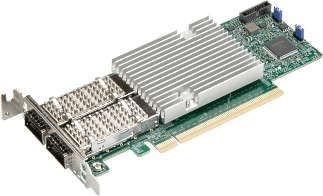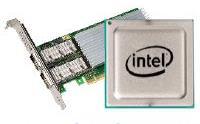Supermicro AOC-S100GC-i2C
| Supermicro newsSupermicro AOC-S100GC-i2C
For today's workshop we will take a look at the Supermicro AOC-S100GC-i2C.
In this article, we'll take a look at the AOC-S100GC-i2C and discuss what makes it suitable for Supermicro.

Starting with ports, there are two QSFP28 ports, each supporting networks up to 100Gbps. Perhaps the biggest advantage of these network cards is support for PCIe Gen4 x16 bus. Previous generations of cards in the 100GbE variant based on PCIe Gen3 x16 did not have enough bandwidth on the PCIe side to fully support two 100GbE network ports with 16 lanes or a single port with 8 lanes. The Intel Ethernet 800 series, Intel considers part of its "foundational" series of cards, making this series the spiritual heir to the Intel Ethernet 500 and Intel Ethernet 700 series.
|
Intel Ethernet Serii 500 |
Intel Ethernet Serii 700 |
Intel Ethernet Serii 800 |
| Fixed Pipeline |
Partially Programmable Pipeline
|
Queuing and management support equipment
|
| SR-IOV i VMDq | Intel Ethernet AVF (Adaptive Virtual Function) |
Fully programmable Pipeline
|
|
Magazine
|
||
| 10GbE | 25/40GbE | 100GbE |
Intel Ethernet 800 series functionality
As we approach the release of the 100GbE bandwidth generation, network cards will require more and more offload functions. Functions that at 10GbE or 25GbE bandwidth were manageable by individual CPU cores, at 100GbE bandwidth will simply cause too much load.
With the release of the Ethernet 800 series, Intel had to increase the range of capabilities in order not to be beaten by the competition. To achieve this, they primarily used three new technologies: ADQ, NVMeoF and DDP. We will discuss each of them.
| Feature | Functionality | Advantages |
| Advanced motion control with technology ADQ (Application Device Queues) | Dedicated hardware queues for individual applications. | Improves the ability to predict application response time, latency and throughput to accelerate network performance. |
| Transport oparty na sieci Ethernet NVMe-oF | Simultaneous support for all transport protocols: iWARP, RoCEv2, TCP | Support for all Ethernet-based storage protocols provides flexibility and a wide range of choices for scalable high-performance storage |
| tehcnology DDP (Enchanced Dynamic Device Personalization) | Ability to define specific protocols for individual segments to increase packet processing efficiency | Enables on-demand support for new and more advanced network protocols to reduce server CPU load, increase throughput and reduce latency. |
ADQ (Application Device Queues)
After looking at ADQ, one of the most important aspects was the ability to define appropriate priorities. Fortunately, Intel makes this possible with relative ease.
- Filtering application-related traffic to a dedicated set of queues
- Application execution threads are connected to specific queues within the ADQ queue set
- Control of application network traffic at exit (Tx)
As a result, with the help of ADQ, Intel's network cards are able to prioritize network traffic based on applications..
NVMeoF
NVMeoF is another area where there has been a huge upgrade. With the Intel Ethernet 700 series of cards, Intel focused on iWARP technology for NVMeoF-related activities. At the same time, some competitors have set their sights on RoCE. Today, the popularity of RoCEv2 is huge. Intel is providing both iWARP and RoCEv2 support in the Ethernet 800 series.
The Intel Ethernet 800 series supports all NVMe-oF Ethernet transports::
- NVMe/RDMA
- Support RoCEv2 RDMA
- Support iWARP RDMA
- Low CPU utilization, low latency and low latency interference
- NVMe/TCP
- Technologia ADQ (Application Device Queues) Reduces latency and interference and increases overall NVMe-oF throughput
- Improves performance by using multiple types of TCP offloading techniques
- Improves performance through the use of multiple types of techaComprehensive congestion control technologies ensure efficiency for large deployments with heavy traffic TCP offloading
| overloads | iWARP | RoCEv2 | TCP |
| TCP Default | YES | YES | |
| ECN | YES | YES | YES |
| DCQCN | YES | ||
| DCTCP | YES | YES | YES |
| TIMELY | YES | YES | YES |
It should be added that NVMe/TCP and ADQ can be combined to approach some of the performance achievable by iWARP and RoCEv2..
DDP (Dynamic Device Personalization)
Dynamic Device Personalization or DDP is another big feature of the network cards described. According to Intel's vision for the foundational series of cards, manufacturing costs are relatively low. As a result, there is only as much ASIC as can be built to keep costs reasonable. While Mellanox tends to add more and more acceleration/load in each generation, Intel has built a logic chip that is configurable.
The main differences between the DDP capabilities of current and previous generation network cards::
DDP packages for Intel Ethernet 700 series
- Most protocols are part of the NVM image
- Limited number of additional protocols enabled per device.
- User must select and load specific DDP protocols for each device on the system after reboot
DDP packages for Intel Ethernet 800 series
- Multiple protocols per DDP packet
- New DDP Package replaces existing loaded DDP Package
- The user can choose which DDP package loads automatically for each device in the system
With the Intel Ethernet 800 series, we get even more possibilities to put custom protocol packets in network cards.
Below is a table showing the protocols and packet types both default and added by the Comms DDP packet.(Green color means that the Comms DDP packet is specific to this packet, while no color means that it is supported by the default operating system packet.):
| Protocols | ||
| MAC | ICMP | NVGRE |
| ETYPE | ICMPv6 | RoCEv2 |
| VLAN | CTRL | GTPv1-C, GTPv1-U + GTP extension headers |
| IPv4 | LLDP | GTPv2-C |
| IPv6 | ARP | PPPoE |
| TCP | VXLAN-GPE | ESP/AH |
| UDP | VXLAN (non-GPE) | L2TPv3 |
| SCTP | GRE | PFCP |
| MPLS | ||
As you can see, with the Comms package you get features such as MPLS processing. These DDP components can also be fully personalized, so users can use the set of protocols that matter most to them to be loaded at startup, while cutting out unnecessary features..
Summary
The Supermicro AOC-S100GC-i2C is a truly intriguing adapter. It features the Intel® E810-CAM2 processor with PCI-E Gen 4 support and backward compatibility with PCI-E Gen 3. In addition, it is a feature-rich adapter that provides support for RoCE, iWarp, DCDB, VXLAN, NVGRE and Geneve. RoCE and iWarp support ensures low latency and high performance on Ethernet networks. The ability to integrate with Supermicro's server management functions via the NC-SI header makes it particularly interesting, for users looking for Intel Ethernet 800 series NICs in their Supermicro server. It is perfect for cloud networking, storage, machine learning, data analytics and HPC.
Related pages:
- Network Cards Supermicro 1Gb 10Gb 25Gb 40Gb 100Gb
- Supermicro 25 Gbit Network Solutions
- FRRouting - Free Range Routing + Supermicro server for ISP
- About Mellanox




